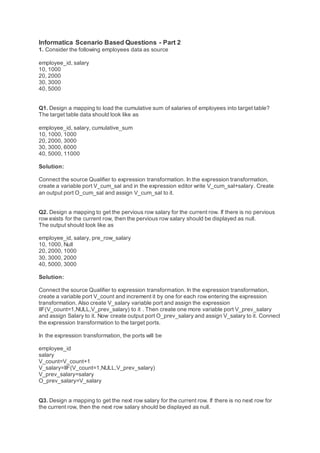
New microsoft office word document (2)
- 1. Informatica Scenario Based Questions - Part 2 1. Consider the following employees data as source employee_id, salary 10, 1000 20, 2000 30, 3000 40, 5000 Q1. Design a mapping to load the cumulative sum of salaries of employees into target table? The target table data should look like as employee_id, salary, cumulative_sum 10, 1000, 1000 20, 2000, 3000 30, 3000, 6000 40, 5000, 11000 Solution: Connect the source Qualifier to expression transformation. In the expression transformation, create a variable port V_cum_sal and in the expression editor write V_cum_sal+salary. Create an output port O_cum_sal and assign V_cum_sal to it. Q2. Design a mapping to get the pervious row salary for the current row. If there is no pervious row exists for the current row, then the pervious row salary should be displayed as null. The output should look like as employee_id, salary, pre_row_salary 10, 1000, Null 20, 2000, 1000 30, 3000, 2000 40, 5000, 3000 Solution: Connect the source Qualifier to expression transformation. In the expression transformation, create a variable port V_count and increment it by one for each row entering the expression transformation. Also create V_salary variable port and assign the expression IIF(V_count=1,NULL,V_prev_salary) to it . Then create one more variable port V_prev_salary and assign Salary to it. Now create output port O_prev_salary and assign V_salary to it. Connect the expression transformation to the target ports. In the expression transformation, the ports will be employee_id salary V_count=V_count+1 V_salary=IIF(V_count=1,NULL,V_prev_salary) V_prev_salary=salary O_prev_salary=V_salary Q3. Design a mapping to get the next row salary for the current row. If there is no next row for the current row, then the next row salary should be displayed as null.
- 2. The output should look like as employee_id, salary, next_row_salary 10, 1000, 2000 20, 2000, 3000 30, 3000, 5000 40, 5000, Null Solution: Step1: Connect the source qualifier to two expression transformation. In each expression transformation, create a variable port V_count and in the expression editor write V_count+1. Now create an output port O_count in each expression transformation. In the first expression transformation, assign V_count to O_count. In the second expression transformation assign V_count-1 to O_count. In the first expression transformation, the ports will be employee_id salary V_count=V_count+1 O_count=V_count In the second expression transformation, the ports will be employee_id salary V_count=V_count+1 O_count=V_count-1 Step2: Connect both the expression transformations to joiner transformation and join them on the port O_count. Consider the first expression transformation as Master and second one as detail. In the joiner specify the join type as Detail Outer Join. In the joiner transformation check the property sorted input, then only you can connect both expression transformations to joiner transformation. Step3: Pass the output of joiner transformation to a target table. From the joiner, connect the employee_id, salary which are obtained from the first expression transformation to the employee_id, salary ports in target table. Then from the joiner, connect the salary which is obtained from the second expression transformaiton to the next_row_salary port in the target table. Q4. Design a mapping to find the sum of salaries of all employees and this sum should repeat for all the rows. The output should look like as employee_id, salary, salary_sum 10, 1000, 11000 20, 2000, 11000 30, 3000, 11000 40, 5000, 11000 Solution: Step1: Connect the source qualifier to the expression transformation. In the expression transformation, create a dummy port and assign value 1 to it.
- 3. In the expression transformation, the ports will be employee_id salary O_dummy=1 Step2: Pass the output of expression transformation to aggregator. Create a new port O_sum_salary and in the expression editor write SUM(salary). Do not specify group by on any port. In the aggregator transformation, the ports will be salary O_dummy O_sum_salary=SUM(salary) Step3: Pass the output of expression transformation, aggregator transformation to joiner transformation and join on the DUMMY port. In the joiner transformation check the property sorted input, then only you can connect both expression and aggregator to joiner transformation. Step4: Pass the output of joiner to the target table. 2. Consider the following employees table as source department_no, employee_name 20, R 10, A 10, D 20, P 10, B 10, C 20, Q 20, S Q1. Design a mapping to load a target table with the following values from the above source? department_no, employee_list 10, A 10, A,B 10, A,B,C 10, A,B,C,D 20, A,B,C,D,P 20, A,B,C,D,P,Q 20, A,B,C,D,P,Q,R 20, A,B,C,D,P,Q,R,S Solution: Step1: Use a sorter transformation and sort the data using the sort key as department_no and then pass the output to the expression transformation. In the expression transformation, the ports will be department_no employee_name
- 4. V_employee_list = IIF(ISNULL(V_employee_list),employee_name,V_employee_list||','||employee_name) O_employee_list = V_employee_list Step2: Now connect the expression transformation to a target table. Q2. Design a mapping to load a target table with the following values from the above source? department_no, employee_list 10, A 10, A,B 10, A,B,C 10, A,B,C,D 20, P 20, P,Q 20, P,Q,R 20, P,Q,R,S Solution: Step1: Use a sorter transformation and sort the data using the sort key as department_no and then pass the output to the expression transformation. In the expression transformation, the ports will be department_no employee_name V_curr_deptno=department_no V_employee_list = IIF(V_curr_deptno! = V_prev_deptno,employee_name,V_employee_list||','||employee_name) V_prev_deptno=department_no O_employee_list = V_employee_list Step2: Now connect the expression transformation to a target table. Q3. Design a mapping to load a target table with the following values from the above source? department_no, employee_names 10, A,B,C,D 20, P,Q,R,S Solution: The first step is same as the above problem. Pass the output of expression to an aggregator transformation and specify the group by as department_no. Now connect the aggregator transformation to a target table.
